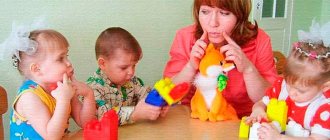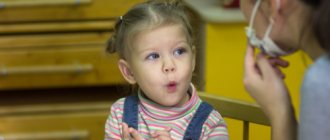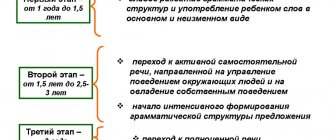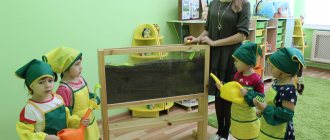Stages of speech development
Most often, the following five stages of speech development are distinguished:
- The period of preparation of verbal speech, or preparatory, or prephonemic stage , is from birth to the end of the first year of life. During this period, the child accumulates experience of interaction with the surrounding reality, on the basis of which he forms ideas about objects and phenomena of the environment that correspond to the words he is learning. The perception of the speech of adults around them contributes to the child’s gradual understanding of words. Thus, during the first period of development of the child’s speech, the child’s passive (impressive) speech activity is formed. The result of this period of speech development is the emergence of the first acts of active (expressive) speech activity - the first words independently pronounced by the child.
- The period of initial language acquisition and the formation of dissected sound speech is from the age of one year to the end of the third year of the child’s life. The need for active (expressive) speech activity is based on the development and complication of the child’s relationships with the outside world and people, and the need for verbal communication becomes one of the most important needs of the child. The development of speech activity at this stage includes the “word-sentence” stage and the stage of two-three-word sentences and is characterized by the rapid growth of the child’s active vocabulary. During the transition from the “word-sentence” stage to the stage of two- or three-word sentences, the child learns to combine words, combine them into small phrases, and further progress from the use of such phrases to the use of compound sentences occurs very quickly. The first three years of a child's life are a sensitive period for speech development . If, for one reason or another, speech in its development does not pass through the listed two periods at a given age, then in the future the process of speech acquisition is significantly hampered.
- The period of development of a child’s language in the process of speech practice and generalization of linguistic facts (stage of independent speech) covers the child’s preschool age, i.e. begins at age three and lasts until age six or seven. This period of speech development is associated with the transition from visual-effective to visual-figurative, and then to the child’s logical thinking. The main feature of this period is that the child’s speech at this time develops in the process of verbal communication, abstracted from the specific situation, which determines the need to develop and improve more complex linguistic forms. Speech reflects not only what the child already knows from his own experience, but also reveals what he does not yet know. The development of logical thinking leads to the child mastering the rules of word formation and sentence formation and independently using these rules in his speech.
- The period of a child’s mastery of written language and systematic language learning covers the child’s school age. Speech becomes the subject of special study, the vocabulary is enriched, the rules for the formation of words and sentences are studied at a conscious level. As a result, speech becomes more perfect, conscious and controlled. The most important role in this is played by the assimilation of written and detailed monologue speech.
- The period of speech improvement after completing the school period is strictly individual. With the completion of schooling, the subsequent increase in vocabulary and other speech abilities occurs to varying degrees in different people. Some people may experience a decrease in the level of speech activity.
Article:
Researchers have been interested in the development of children's speech for a long time.
Since antiquity, the appearance of speech in a child has been associated with its emergence in phylogenesis and was considered to stem from the internal development of his abilities without the influence of the linguistic environment (Herodotus, 1972). The first systematic observations of the process of speech development in children date back to the end of the 18th century. The German scientist D. Tiedermann (1787) published a review of his son's speech development. C. Darwin, V. Preyer, K. and V. Stern, A. Gregoire, I. A. Baudouin de Courtenay, N. A. Rybnikov, A. N. Gvozdev recorded the speech of their children and conducted research in the field of children's speech. A. N. Gvozdev covered in detail the stages of a child’s sequential mastery of various aspects of the Russian language.
The theoretical basis of Russian science on children's speech consists of the works of L. S. Vygotsky, P. Ya. Galperin, A. N. Gvozdev, I. N. Gorelov, B. M. Grinshpun, N. I. Zhinkin, A. V. Zaporozhets , I. A. Zimnyaya, R. E. Levina, A. N. Leontyev, A. A. Leontyev, A. R. Luria, V. K. Orfinskaya, E. N. Tikheeva, R. M. Frumkina, M E. Khvattseva, N. Kh. Shvachkina, D. B. Elkonina. In recent decades, I. N. Gorelov, N. S. Zhukova, E. I. Isenina, E. S. Kubryakova, R. I. Lalaeva, N. I. Lepskaya, E. Yu. Protasova, T B. Filicheva, V. K. Kharchenko, S. N. Tseitlin, A. M. Shakhnarovich and others.
At the present stage of development of science, speech is defined as a form of communication mediated by language that has developed historically in the process of material transformative activity of people. From the point of view of linguistics, speech is a certain sequence of linguistic units (phonemes, morphemes, words, sentences), regulated by the laws of language and the work of consciousness that forms this or that thought (F. M. Berezin, B. N. Golovin, 1979).
In psycholinguistics, speech is considered as a specifically hierarchically organized activity (P. P. Blonsky, M. Ya. Basov, L. S. Vygotsky, I. N. Gorelov, N. I. Zhinkin, A. N. Leontyev, S. L. Rubinshtein, I.M. Sechenov). Speech activity is a set of speech actions that has a motive, goal, means, methods of implementation, attitudes and results of activity. In the structure of speech activity, stages, phases and levels are distinguished (L. S. Vygotsky, I. A. Zimnyaya, A. A. Leontyev, A. R. Luria, etc.). The means or instrument of speech activity is language as a system of signs and landmarks necessary for human activity in the material and social world around him. Speech activity is both the specialized use of speech for communication, in which the content is encoded and decoded, and the process of internal self-regulation of society (A. A. Leontyev, 1969, 1999). Language and speech activity are involved in the formation and functioning of the mental reflection of reality and the mediation of people’s lives.
The psycholinguistic theory of speech activity, concepts about the processes of generation and perception of speech reveal the structure and features of these processes, make it possible to determine the ways of formation of the main components of speech and the potential possibilities of speech development.
L. S. Vygotsky drew up a diagram of the internal psychological organization of the process of generating speech as a sequence of interconnected phases of activity, including the stages: 1) motivation, intention; 2) thought – speech intention; 3) mediation of thought in the inner word; 4) mediation of thought in the meanings of external words - implementation of the internal program; 5) mediation of thought in words – acoustic-articulatory realization of speech. Motivation is the first link in the process of generating speech. From motivation, from human needs, thought arises as a unit of thinking. L. S. Vygotsky considered the meaning of a word to be the unit of speech thinking. He also singled out “inner speech” – speech “for oneself”. In inner speech, a thought turns into a word consisting of predicates, and words pass from intent into meaning, verbal designations of elements of meaning arise. Inner speech is subsequently realized in external speech. The movement from thought to word, according to L. S. Vygotsky, occurs in the form of the transformation of personal meaning (the language of thought) into a generally understandable meaning (the language of the word).
N. I. Zhinkin, continuing the work of L. S. Vygotsky, suggested that in the human mind there is a universal subject code (UPC), denoting reality in the form of diagrams, sensory images. According to N.I. Zhinkin, the movement from thought to word in inner speech begins with the recoding of the internal non-verbal “subject-scheme” code into verbal language. Words and statements are synthesized each time according to certain rules.
A. R. Luria believed that in the processes of generating and perceiving speech, “thought uses language codes,” and the word is a complex coding system that implements the functions of designation, analysis and generalization. Speech, according to A. R. Luria, is a system of syntagmas (whole statements). The process of generating speech according to A. R. Luria includes the following stages: 1) motive; 2) intention; 3) internal speech - “a mechanism that transforms internal subjective meanings into a system of external, expanded speech meanings”; 4) formation of a deep syntactic structure; 5) external speech utterance, based on a superficial syntactic structure.
A detailed analysis of speech activity was carried out in the 1960-1970s by the Moscow psycholinguistic school (A. A. Leontyev, T. V. Ryabova-Akhutina, etc.). A. A. Leontyev summarized the fundamental principles of scientists into the concept of speech generation and perception. Researchers have found that the theory of speech utterance generation is based on a heuristic principle - the speaker can choose different models of speech generation.
According to A. A. Leontyev, the model of speech generation consists of stages: substage - motivation, orientation; Stage 1 – internal programming. The internal program corresponds only to the content core of the future utterance (subject, predicate or object); Stage 2 – grammatical and semantic implementation of the internal program; Stage 3 – motor programming. At the initial stage, orientation in the situation is carried out and communicative intentions are formed. At the stage of creating an internal program, speech intentions are mediated by a code of personal meanings and the basic concept of the utterance is created. This process is ensured by dialectical unity and integration of thought-speech-language operations. At the next stage, the idea is transformed into a statement program based on the semantic structuring of reality and its reflection in the signs of the language code. In internal speech, the semantic and grammatical implementation of the utterance occurs. At the final stage, the sound realization of the utterance occurs.
Under the leadership of A. M. Shakhnarovich, research was carried out on the problem of forming a utterance program in children at the stage of a one-word sentence. It was found that during this period the child performs predication (correlating what is expressed in a sentence with reality). Researchers have identified the following stages in the development of predicativeness in children: 1) the word-sentence and the situation are not separated, the use of gestures is typical; 2) the stage of semantic syntax – connecting the elements of a situation without expressing the connection between them; 3) connecting elements of the situation using intonation; 4) a detailed grammatically structured statement.
T.V. Akhutina, while studying aphasic disorders, also developed a model for the generation of speech utterances and determined the levels of speech generation: 1) motivation; 2) thought; 3) internal semantic program - semantic syntax and choice of meanings in internal speech; 4) semantic structure of a sentence – semantic syntax and choice of linguistic meanings of words; 5) lexical and grammatical structure of a sentence – grammatical structuring and choice of words according to form; 6) motor program of the syntagma – kinetic programming and choice of articles; 7) articulation. In children at the early stages of speech development, the structures of utterances (semantic and phasic) are not divided and are organized by semantic syntax. The child uses a word to highlight the most significant component of the situation - the predicate (theme), and the subject (rheme) is implied. T.V. Akhutina’s research showed the complexity of semantization in the process of speech production. The author makes an important conclusion that the stages of a child’s language competence correlate with the levels of speech production in an adult.
I. A. Zimnyaya identifies 3 levels of speech production : 1) motivational-inspiring - containing motive and communication intention; 2) the process of forming and formulating thoughts – meaning-forming and formulating phases; 3) implementation of the utterance in external speech.
In the works of A. A. Leontiev, T. V. Akhutina, I. A. Zimnyaya, a unity of views on the nature of speech generation can be traced. The process of speech production is considered as a purposeful, motivated activity that has certain stages and levels. The internal program of utterance is provided by various code systems (speech motor, auditory, visual, subject-schematic codes). In the process of choosing words, there are three stages of search: associative according to the semantic appearance of the word; by the sound appearance of the word; based on the subjective probability of the word's characteristics.
The studies of L. S. Vygotsky, N. I. Zhinkin, A. R. Luria, A. A. Leontyev and others formed the basis of the theory of speech activity. Its main position is the idea that a child’s speech develops as a result of the generalization of linguistic phenomena, speech perception and his own speech activity.
Speech perception occurs according to the same patterns as other perceptions. There are two situations of perception - the primary formation of a perception image and the recognition of an already formed image (A. A. Bodalev, 1982).
Representatives of the Moscow Psycholinguistic School believe that most situations of speech perception are associated with the use of an already formed standard for motor and sensory characteristics. The word has a stable motor side, a stable sound and a graphic image. The sound appearance of a word is a unit of semantic perception. Phonemes, play a meaningful role . L. S. Vygotsky wrote that the unit of speech in sound is the phoneme, i.e., a further indecomposable phonological unit that retains all the basic properties of the entire sound side of speech in the function of designation. In the Russian language, the distinctive features of meaning are: 1) deafness - voicedness (tom - house); 2) hardness - softness (was - reality); 3) stress – unstress (flour – flour). The differentiation of speech sounds and phonemes is ensured by phonemic hearing - the highest form of speech hearing. , the motor side of speech plays an important role in the process of speech generation and perception - a set of generalized articles that are distinguished by clear phonemic features and ensure the stability of the sound and expression of a word.
A word is a unity of sound and meaning. The components of the semantics of a word are subject reference, meaning and meaning. The word is closely connected with objective images and is their reflection. The meaning of a word is a generalized and stable reflection of the subject content included in the social and practical activity of a person. It identifies essential features, generalizes them, and on this basis assigns an object to a certain category. L. S. Vygotsky emphasized that in the process of child development, a word changes its semantic structure, is enriched by a system of connections and becomes a generalization of a higher type. The meaning of a word develops in two aspects: semantic and systemic. Semantic development consists in changing the objective attribution of a word, which acquires a categorical character. The systemic development of the meaning of a word is associated with the fact that the functional system behind a given word changes (in the early stages of a child’s development - this is the affective meaning, in preschool age - previous experience, images, memory, in an adult - a system of logical connections, the inclusion of the word in hierarchy of concepts). The meaning of a word is the individual meaning that a word acquires for a person in each specific situation, generated by a person’s entire life experience (A. N. Leontiev, 1972; A. R. Luria, 1969, 1975; L. S. Vygotsky, 2000; L S. Tsvetkova, 1985).
The mechanism of semantic perception of a statement according to I. A. Zimnyaya consists of two phases: 1) on the basis of word identification, a decision is made about the semantic link (syntagm, two-word combination) and about the connections between semantic links; 2) the phase of meaning formulation - generalizing the result of perceptual-mental work and translating it into a whole unit of understanding - the general meaning of the message.
Speech in the human mental sphere occupies a certain place and implements functions on the basis of which communication activities are carried out. Functions of speech according to L. S. Tsvetkova: communicative function: speech is a means and form of communication; function of regulating activity, organizing and linking other mental processes; generalization function: the word analyzes and identifies objects that are homogeneous in content into certain categories; cognitive function: means and form of cognitive activity; nominative function: the word denotes and replaces objects, objects, phenomena; emotional-expressive function: the specific meaning of words is conveyed using intonation, voice modulation, rhythmic-melodic component, pauses, gestures, and facial expressions. All functions of speech are interconnected and mediate each other.
The theoretical and methodological concepts of L. S. Vygotsky, A. R. Luria, A. N. Leontyev reveal the deep relationship between speech and the formation of higher mental functions. Psychologists (L. S. Vygotsky, A. N. Leontyev, A. V. Zaporozhets, A. A. Lyublinskaya, G. L. Rosengart-Pupko, etc.) convincingly showed that mastering the language system rebuilds all the basic mental processes in child. The word turns out to be a powerful factor that qualitatively changes mental activity, improves the reflection of reality and mediates new forms of attention, memory, imagination, thinking, and activity. As speech develops, consciousness is transferred from the level of direct, sensory experience to the level of generalized, rational knowledge.
Speech takes part in practical, visual and abstract thinking, identifying the essential features of perceived phenomena and situations that the word denotes and generalizes. Speech is a way of forming and implementing thinking, cognitive activity, a way of storing universal human social experience. The word allows you to reveal the general and generalized meaning or meaning of a thing, to conjure up images-representations of different modalities (visual, auditory, tactile) and operate with them.
Research by A. R. Luria, B. G. Ananyev, G. L. Rosengart-Pupko and others also showed that in the early stages of speech formation, a significant role belongs to the processes of perception and image-representations. L. S. Vygotsky wrote that every word has an initial representation, or image, and the growth of a child’s vocabulary is directly related to the formation of numerous and varied connections between the images of objects, phenomena and the words denoting them. N. Kh. Shvachkin studied the development of the meanings of a child’s first words. The earliest meanings are based on visual generalizations based on the striking external features of objects. The next type of meaning is formed on the basis of similar and different features of an object combined in one representation. The third type of meaning is characterized by the general and most constant features of the subject. S. L. Rubinstein believed that a word is a reflection of an object, and their connection is mediated either through the generalized content of the word, through a concept, or through an image.
Perception under the influence of speech becomes more accurate and acquires a selective and systemic character, becomes meaningful, categorical (L. S. Vygotsky, 2000). memory and abstract thinking arise ; in the motor sphere, objective actions are formed on the basis of elementary movements and actions .
Speech plays a significant role in the formation of personality, voluntary forms of regulation and control of behavior. I. P. Pavlov called speech the highest regulator of human behavior, and L. S. Vygotsky considered it as the main means of personality development and control of human behavior (first external, then internal).
“Ontogenesis of language ability is a complex interaction, on the one hand, of the process of communication between adults and a child, a process that develops step by step; on the other hand, the process of development of the child’s objective and cognitive activity. And what develops in the process of development of a child’s speech is not language, but the nature of the interaction of the linguistic means at the child’s disposal and the nature of the functioning of these means, i.e., the way of using language for the purposes of cognition and communication” (A. A. Leontiev, 1997). This understanding of the development of children's speech goes back to L. S. Vygotsky.
“The main and decisive factor in the development of a child’s speech is not the mastery of the denoting function of a word in itself, but the fact that the child acquires the opportunity through words to enter into communication with others” (S. L. Rubinstein, 2000).
V. von Humboldt said that “children’s acquisition of language is not an adaptation of words, putting them together in memory and reviving them with the help of speech, but the development of language ability with age and exercise.”
A child masters language by extracting it from speech, constantly analyzing and systematizing linguistic facts. Mastering a language means mastering a set of linguistic units (sounds, morphemes, words, sentences) and the rules for their creation and use in speech activity. This process is mainly carried out unconsciously and depends on the child’s ability to analyze the speech of adults. “There is a general strategy for mastering language rules: first, the basic, deep models of language and the language rules based on them are comprehended” (S. N. Tseitlin, 2000).
Bibliography:
1. Akhutina, T. V. Generation of speech. Neurolinguistic analysis of syntax. - M.: Publishing house Moscow. University, 1989. - 215 p. 2. Vygotsky, L. S. Psychology. – M.: Publishing house “EXMO-Press”, 2000. – 1008 p. 3. Vygotsky, L. S. Development of higher mental functions. – M.: Publishing House of the Academy of Pedagogical Sciences of the RSFSR, 1960. – 500 p. 4. Galperin, P. Ya., Zaporozhets, A. V., Karpova, S. N. Current problems of developmental psychology. – M.: Moscow State University Publishing House, 1978. – 117 p. 5. Gvozdev, A. N. Questions of studying children's speech. – M.: Publishing House of the Academy of Pedagogical Sciences of the RSFSR, 1961. – 471 p. 6. Zhunkin, N. I. Mechanisms of speech. – M.: Publishing House of the Academy of Pedagogical Sciences, 1958. – 370 p. 7. Zimnyaya, I. A. Linguistic psychology of speech activity: Izbr. psychol. works/ – M.: Publishing house Mosk. psychol.-social institute; Voronezh: MODEK, 2001. (Psychologists of the Fatherland). – 432 p. 8. Leontyev, A. A. Fundamentals of psycholinguistics. - M.: Smysl, 1999. - 287 p. 9. Leontiev, A. A. Language, speech, speech activity. – M.: Education, 1969. – 214 p. 10. Luria, A. R. Main problems of neurolinguistics. – M.: Publishing house Mosk. University, 1975. – 253 p. 11. Luria, A. R. Language and consciousness / Ed. E. D. Chomsky. – Rostov-on-Don: Phoenix, 1998. – 416 p. 12. Luria, A. R., Yudovich F. Ya. Speech and development of mental processes in a child. – M.: Publishing House of the Academy of Sciences of the RSFSR, 1956. – 93 p. 13. Rosengart-Pupko, T. L. Development and education of a child from birth to three years. – M.: Education, 1965. – 200 p. 14. Rubinstein, S. L. Fundamentals of general psychology. – St. Petersburg: Peter, 2000. – 720 p. 15. Tsvetkova, L. S. Introduction to neuropsychology and rehabilitation training. - Tutorial. – M.: Moscow. psychol.-social. Institute, 2000. – 148 p. 16. Tseytlin, S. N. Language and the child: Linguistics of children's speech: A textbook for students of higher educational institutions. – M.: Humanitarian Publishing House, 2000. – 240 p. 17. Shakhnarovich, A. M., Yuryeva, N. M. Psycholinguistic analysis of semantics and grammar (based on the ontogeny of speech). – M.: Nauka, 1990. – 168 p. 18. Shvachkin N. Kh. Development of phonemic perception of speech at an early age // Proceedings of the APN of the RSFSR. – 1948. – Issue. 13. – p. 101-132.
Patterns of speech development
General patterns of human speech development come down to the following main aspects:
- The determining influence of social factors in the development of speech: a child acquires language and masters speech in the process of direct interaction with people around him and in the process of specially organized training. Speech is the main means of communication, and communication is a condition for the development of speech.
- Unity of speech development and cognitive processes : speech development is carried out together with the development of memory, attention, thinking, etc. Cognitive processes are manifested in speech and are the basis of its development. At the same time, cognitive processes themselves develop in speech activity and on its basis.
- Advancement in the development of the passive form of speech in relation to its active form : the passive form of speech is consistently ahead of the active one; The volume of speech material that children can understand is always greater than what they use in conversation.
Speech development disorders in children
In recent years, the number of children who, due to disorders in speech development, must be referred to a speech therapist, speech pathologist, or neurologist, has been growing catastrophically. And if in my childhood it was considered “normal” to speak at the age of 1.5-2, now, God willing, to form speech by the age of three. And such problems occur 4 times more often than in the generation of mothers and fathers of today’s children.
At preschool age, a speech disorder such as stuttering may first appear. It occurs in children with a weak nervous system. Especially when some kind of psychological trauma is added - the death or illness of a parent, violence, aggressive behavior of others, both physical and psychological.
Many factors play a role in the occurrence of speech development disorders - the increasingly common pathology of pregnancies, birth injuries and unimportant ecology, but most importantly - the lack of constant voicing of the child’s actions. Busy mothers are increasingly silent, they will give a couple of guidelines - “you can’t”, “let’s go”, “don’t touch”, and that’s all! What kind of phrasal speech is there?
Or, at the other extreme , they begin to lisp with the child or deliberately slip into the highly intellectual speech of SpongeBob. The child honestly believes that this is a role model, because his most necessary and beloved people speak to him exactly like that.
An excellent way out of their situation is to start doing articulation gymnastics with the child.
Exercises for speech development
Exercises for speech development should correspond to the stage of speech development.
- At the first and second stages of speech development, exercises to develop articulation (pronouncing sounds) are relevant, for example: how does a beetle buzz? W-w-w-w-w. How does a cow moo? Mooooo. And so on.
- At the beginning of the second stage - pronouncing words, for example: Who says “meow”? - Cat. Who says "kwa"? - Frog. And so on.
- At the second stage - making sentences based on pictures, for example: children are given pictures depicting actions (a boy does exercises; a girl has lunch; mother hangs up laundry, etc.). The child must say what is shown in the picture.
- At the third stage - compiling stories from pictures, etc.








